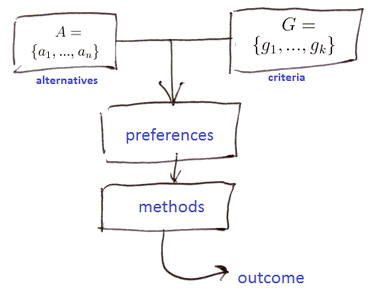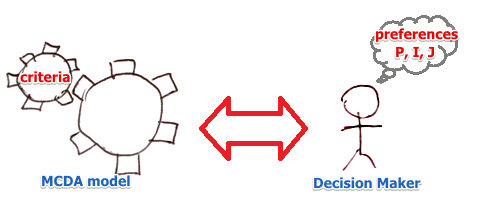Multi-Criteria Decision Aid
This is a tool that helps a decision maker to choose a solution when he is facing conflicting criteria and cannot decide.
For example, you want to buy a new car:
- One is expensive, speed is good;
- another is cheap but slow and with little comfort.
- These criteria (cost vs speed) are conflicting.
We need to find a compromise that answers the expectation of a decision maker

- Step 1: Define the set of alternatives $A = {a_1, …, a_n}$
- Step 2: Define the set of criteria $G = {g_1, …, g_k}$
- Step 3: Define the Preferences (the expectations of a decision maker)
- Step 4: Apply methods to find the best alternative
Alternatives
$A$ - set of alternatives (actions, options, items, decisions, etc)
$A$ can be
- finite or infinite
- countable or uncountable
- stable (always the same) or evolving
Criteria
A ‘‘criterion’’ $g_i$ is a mapping from the set of alternatives $A$ to some totally ordered set $E_i$:
- $g_i: A \mapsto E_i$
- $g_i \in G$ form a set of criteria
With $E_i$ we can rank all elements of $A$ from best to worst
Examples:
- $E = \mathbb{R}$
- $E = {\text{VB}, \text{B}, \text{M}, \text{G}, \text{VG}}$
A set can be:
- ordinal (operations $<, =, >$)
- $E = {\text{VB}, \text{B}, \text{M}, \text{G}, \text{VG}}$
- interval (operations $<, =, >, +, -$)
- temperature
- ratio (operations $<, =, >, +, -, \cdot, / $)
- $E = \mathbb{R}$
Restrictions on $G$:
- For a set to be ordered, operations $<$ and $>$ must be defined there
- A set of criteria $G$ ideally should form a Consistent Family of Criteria
Dominance Principle
Some alternatives can be eliminated by Dominance principle
- If for two alternatives $a$ and $b$ for all criteria they are equally good
- but there exists one criteria at which $a$ is better than $b$
- then $b$ is dominated by $a$ and will never be chosen
Consider this example
- we’re choosing a car
- there are 4 criteria: price, power, consumption, comfort
- there are 6 alternatives
| Price | Power | Consumption | Comfort | Avg A. | 18 | 75 | 8 | 3 | Sport | 18.5 | 110 | 9 | 2 | Avg B. | 17.5 | 85 | 7 | 3 | Lux 1 | 24 | 90 | 8.5 | 5 | Exonomic | 12.5 | 50 | 7.5 | 1 | Lux 2 | 22.5 | 85 | 9 | 4 |
By Dominance principle:
- We see that ‘'’Avg B’’’ is always better than ‘'’Avg. A’’’
- then nobody will ever choose Avg A: A is dominated by B
- but no other alternative can be eliminated this way
How to chose which one is the best?
- Need ‘‘subjective’’ preferences
Preferences
To be able to find the best solution we need to know ‘‘subjective preferences’’
- these are binary relations provided by a decision maker
- defined analogously to Voting Theory Relations
Given two alternatives $a$ and $b$ a decision maker can say if
- $a \ P \ b$ or $b \ P \ a$: $a$ is preferred to $b$ - ‘‘the preference relation’’
-
$a \ I \ b$ - the indifference relation (not transitive see Luce’s Coffee Cups) - $a \ J \ b$ - the incomparability relation, when you cannot compare things

How to represent a Decision Maker’s preferences in some model?
With Modeling Preferences:
- Complete Pre-Order Preference Structure ($I$ is not transitive)
- SemiOrder Preference Structure ($I$ is transitive, no $J$)
- Partial Order Preference Structure (with $J$)
- Valued Preference
Important condition when modeling preferences:
Methods
There some important families of criteria:
- MAUT (Utility): Multi-Attribute Utility Theory
- Outranking methods
Outranking
Outranking methods perform pair-wise comparisons (like in the Condorcet’s Rule)
Most famous methods:
Problems of outranking methods:
Multi-Objective Optimization
Once we found the Pareto-optimal set of solutions in a problem, we need to find the best solution, and MCDA can help with it
Links
- http://www.lamsade.dauphine.fr/~bouyssou/TranspaOrbel16.pdf
- http://www.liacs.nl/~emmerich/moda03mcda.pdf
Sources
- Decision Engineering (ULB)
- Multiple Criteria Decision Analysis: State of the Art Surveys, 2005